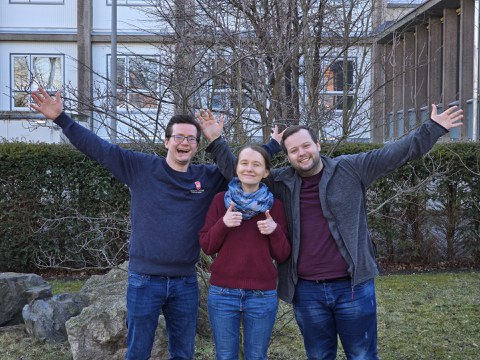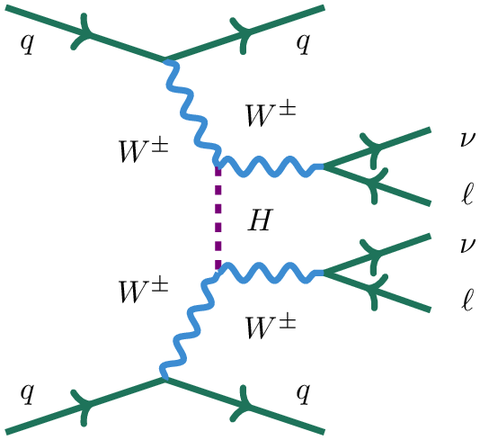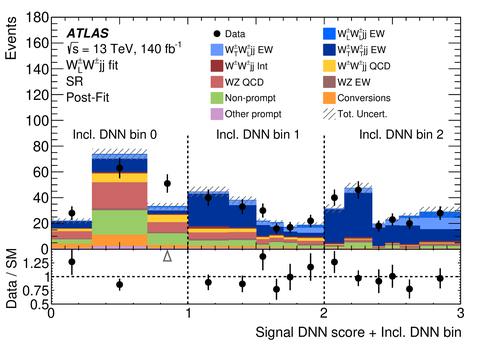17.03.2025
Erste „Polarisationsbrille“ für das „Streulicht“ der schwachen Wechselwirkung

Max Stange (links), Mareen Hoppe (Mitte) und Erik Bachmann (rechts) symbolisieren mit ihren Armen jeweils transversale T- , longitudinale L- und noch einmal transversale T-Polarisation.
Ob beim Angeln, Segeln, Kanufahren, Kitesurfen, Windsurfen oder SUP: mit einer Polarisationsbrille können Lichtreflexionen von der Wasseroberfläche eliminiert werden, die Belastung der Augen wird reduziert, man behält den vollen Durchblick und verpasst keinen dicken Fisch unter der Wasseroberfläche. Der Grund dafür ist, dass die elektromagnetischen Felder von reflektierten Lichtwellen in einer ganz bestimmten Richtung ausgerichtet („polarisiert“) sind, die man mit einer geeigneten Brillenstruktur ausfiltern kann. Man bekommt weniger Streulicht in die Augen und kann unter die Wasseroberfläche sehen.
Den Photonen der elektromagnetischen Wechselwirkung entsprechen bei Proton-Proton-Kollisionen am Large Hadron Collider (LHC) des CERN die bei der subnuklearen schwachen Wechselwirkung abgestrahlten W-Teilchen. Im Gegensatz zu dem uns allen bekannten Licht der elektromagnetischen Wechselwirkung haben diese schweren W-Teilchen nicht nur zwei in Bezug zur Flugrichtung transversale (T-)Polarisationen, sondern noch eine weitere, longitudinale L-Polarisation in Flugrichtung. Diese L-Polarisation nähme in der W±W± - Streuung sogar mit höherer Energie unbeschränkt zu – und führte damit zu einer Verletzung der Grundregeln der Physik – wenn die Beteiligung des Higgs-Bosons (Abb. 1) die Zunahme der L-Polarisation nicht ganz genau kompensieren würde.

Abb. 1: Der Beitrag des Higgs-Bosons (H) in der Streuung zweier W±-Teilchen, die von je einem Quark (q) in im LHC kollidierenden Protonen abgestrahlt wurden.
Wäre das Higgs nicht schon gefunden, mit der Messung der L-Polarisation in der W±W± - Streuung hätte man seine Existenz in jedem Fall beweisen oder widerlegen können. Dieses „no-lose-theorem der W±W± - Streuung“ war wissenschaftlich ausschlaggebend bei der Entscheidung für den Bau des 27 Kilometer großen LHC. Die Messung des vollständig L-polarisierten Anteils W±L W±L (LL) in der W±W± -Streuung bleibt aber auch nach der Higgs-Entdeckung der „dicke Fisch“ unter den Zielen des LHC, denn sie erlaubt weitere Rückschlüsse auf die Eigenschaften des neuartigen Higgs-Bosons und testet die Konsistenz und Vollständigkeit des zugrundeliegenden Brout-Englert-Higgs Mechanismus.
In 2014 konnte die Dresdner Teilchenphysikgruppe gemeinsam mit anderen Forscher:innen des ATLAS-Experiments das erste Mal nachweisen, dass W± -Teilchen überhaupt aneinander streuen, während sich Lichtstrahlen ja bekanntermaßen ungehindert gegenseitig durchdringen. Nun ist es den Dresdner Forscher:innen gelungen, diese gestreuten W-Teilchen mit einer „Polarisationsbrille“ zu betrachten und verschiedene Polarisationszustände voneinander zu trennen.
Mit den zwischen 2015 und 2018 aufgezeichneten Daten des ATLAS- Experiments im sogenannten „Run 2“ des LHC haben sie eine Methode entwickelt, aus der Energie- und Winkelverteilung der beiden in der W±W± -> W±W± Streuung entstehenden W-Teilchen die jeweiligen Anteile ihrer Polarisationen (TT, TL/LT und LL) getrennt zu messen. Dabei wurde hochoptimierte künstliche Intelligenz in Form einer Kombination zweier Tief Neuronaler Netze (DNN) eingesetzt. In Abb. 2 erkennt man, dass das „Inclusive DNN“ die W±W± -> W±W± -Streuung (blau) besonders in Bin 2 anreichert und innerhalb dieses Bins dann das „Signal DNN“ jeweils die TL/LT-Anteile (hellblau) und den LL-Anteil (mittelblau) rechts anhäuft. Daraus ergibt sich das erste Mal eine signifikant von Null verschiedene Summe der TL/LT+LL Anteile (26% des beobachteten Gesamtstreuquerschnitts von 3,4 fb, entsprechend (0,9±0,3) fb) und damit die Bestätigung der Hypothese, dass in dieser Streuung auch L-polarisierte W-Teilchen entstehen.

Abb. 2: Verteilung der beobachteten Ereignisse auf Bins zweier Tief Neuronaler Netze (DNN). Die farbigen Flächen stellen den besten Fit der Anteile von WW-Streuung (blau) und Untergrund (bunt) an die Daten (schwarze Punkte mit Fehlerbalken) dar.
Es ist mit dieser „Polarisationsbrille“ somit gelungen, das störende TT-Streulicht (dunkelblau) herauszufiltern und erste Blicke auf die L-Polarisation zu werfen. Die reine LL-Streuung (mittelblau, der „dicke Fisch“ unter der Wasseroberfläche) wurde dabei zwar noch nicht signifikant beobachtet, aber es lässt sich für sie eine obere Grenze von 0,45 fb ableiten, nicht viel höher als die mit den Higgs-Eigenschaften des Standardmodells erwarteten (0,29±0,07) fb (10% des vorhergesagten Gesamtstreuquerschnitts). Damit ergeben sich bereits jetzt starke Einschränkungen auf Theorien jenseits des Standardmodells. Eine signifikante Etablierung und Vermessung des LL-Anteils wird eine sehr genaue Überprüfung der Higgs-Eigenschaften ermöglichen, erfordert jedoch noch deutlich mehr Daten und/oder eine weiterentwickelte „Polarisationsbrille“, die in den nächsten Jahren am LHC gesammelt und entwickelt werden sollen.
Bei der Entwicklung dieser neuen Methode waren in der Dresdner Gruppe unter Leitung von Frank Siegert drei Promovierende in verschiedenen Aspekten der Datenanalyse führend beteiligt, ohne deren Beträge die Entwicklung nicht möglich gewesen wäre:
Max Stange hat als Hauptverantwortlicher in einem internationalen Forschungsteam mit Kolleg:innen aus Deutschland, China, Großbritannien und den USA zusammengearbeitet und die höchstmögliche Signifikanz aus den zur Verfügung stehenden Daten herausgekitzelt. Gleichzeitig achtete er penibel darauf, dass die systematischen Unsicherheiten zuverlässig abgeschätzt sind. Unterstützung bekam er dabei von Erik Bachmann, dessen Expertise in Maschinellem Lernen und der DNN-Parameteroptimierung dabei half, das winzige Messsignal vom Untergrund zu trennen. Mareen Hoppe lieferte den für diese Methode notwendigen theoretischen Input. Ihre neuartige Entwicklung einer Simulation von polarisierter W-Produktion im in Dresden entstandenen und inzwischen weltweit verwendeten Programmpaket SHERPA ermöglichte zum ersten Mal eine robuste theoretische Interpretation der Messung.
Die Relevanz dieser Beiträge spiegelt sich auch darin wider, dass alle drei Dresdner Forscher:innen in den nächsten Wochen für hochkarätige Konferenzbeiträge eingeladen sind. Max Stange wird am 29. März bei einer der wichtigsten Tagungen der Teilchenphysik in Moriond dieses Resultat als ATLAS-Highlight vorstellen. Erik Bachmann hat eine Vortragseinladung zum Jahrestreffen des größten europäischen Forschungsverbunds in diesem Feld, COMETA, im April in Krakow. Da in diesem Verbund sowohl Experiment als auch Theorie involviert sind, wird auch Mareen Hoppe teilnehmen und ist eingeladen, die aktuellen Theorieentwicklungen des gesamten Bereichs vorzustellen.
Dieses erfolgreiche Zusammenspiel zwischen Experiment und Theorie ist ein besonderes Merkmal der Dresdner Professur für Teilchenphysik. Für die weiteren Messungen am LHC wird es immer mehr darauf ankommen, durch methodische und theoretische Verbesserungen höhere Signifikanzen aus bestehenden und zukünftigen Daten herauszukitzeln.
Autoren: Michael Kobel und Frank Siegert
Weitere Informationen:
Originalveröffentlichung:
https://cds.cern.ch/record/2926878
https://arxiv.org/abs/2503.11317
Konferenzvorträge:
29.3.2025, The 59th Rencontres de Moriond, La Thuile
- Max Stange: Vortragsfolien
28.4.2025 2nd COMETA General Meeting, Krakau
- Erik Bachmann: Vortragsfolien
- Mareen Hoppe: Vortragsfolien
Forschung zur WW-Streuung an der TU Dresden:
https://tu-dresden.de/mn/physik/iktp/arbeitsgruppen/teilchenphysik/forschung
LHC und ATLAS-Deutschland:
https://lhc-deutschland.de/aktuelles/news
https://lhc-deutschland.de/lhc_deutschland/fsp_atlas
WW-Streuung und -Polarisation bei ATLAS und am CERN:
https://atlas.cern/updates/feature/vector-boson-scattering
https://atlas.cern/Updates/Briefing/VBS-Polarisation
https://home.cern/news/news/physics/atlas-gets-under-hood-higgs-mechanism
Ansprechpersonen:
Erik Bachmann
Mareen Hoppe
Max Stange